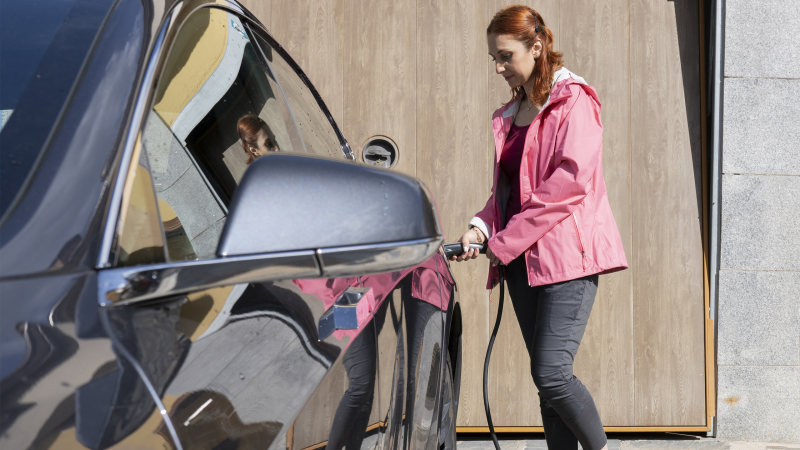Installing an electric vehicle charging station at home – what to know

The vast majority of electric vehicle (EV) drivers opt to install a charging station at their home. What does a home EV charging station look like? How much does it cost? And what do you need to know? Let’s take a look at the things you need to consider below.
EV charging basics
First, let’s talk basics. A charging station or charger – known officially as Electric Vehicle Supply Equipment (EVSE) – is basically just industry lingo for a power cord. Just like cell phones, EVs require a dedicated cord to charge up.
There are three different levels of chargers:
- Level 1 chargers are basic cords that use standard household outlets, same as your cell phone or toaster. These typically come with your EV at no extra cost, but they charge the car at a relatively slow rate (2-5 miles of charge per 1 hour of charging time).
- Level 2 chargers can charge EVs much faster (10-20 miles of charge per 1 hour of charging time), but they require a dedicated electrical line and a 240-volt outlet (same as a clothes dryer uses), which results in some extra installation needs.
- Level 3 chargers are the fastest chargers, but they typically only exist in public spaces – akin to gas stations – due to cost and electrical load requirements.
Bottom line: The vast majority of EV drivers install some kind of Level 2 charger at their home.
How much does it cost to install an electric car charger at home?
According to HomeGuide, Level 2 home charging stations cost between $350 and $900, on average, and the additional cost of labor to install a 240-volt outlet is about $400 to $1,700. In some areas, there may be government incentives available to cover a portion of these costs.
That said, let’s break down these costs a little further:
- The charger itself. The cost of the charger itself can range from a few hundred dollars to a few thousand dollars, depending on factors such as size, charging speed, cord length, Wi-Fi capability, weatherization, and other features.
- Installation needs. Level 2 home chargers require a 240-volt outlet. Depending on your home, installing such an outlet can be relatively affordable – or somewhat costly.
- Easy mode: If you happen to have an electrical panel near where you park your car, installation may cost between $250 and $400.
- Most common circumstance: Because many garages and driveways aren’t already equipped with an electrical panel nearby, or may even lack power all together, most installations involve running a new dedicated line from the electrical panel inside the home to wherever you park your car. These types of installations run anywhere from $400-$1,700.
- More complicated: Costs generally only exceed those amounts in cases where there is no room for additional breakers on the electrical panel – meaning the homeowner might have to install an additional panel (costing approximately $1,500-$4,500).
- Electricity. Of course, after you install a home charger, you’ll start using it – and that means using a lot more electricity at home, too. While the price of electricity varies greatly across the country and changes all the time, driving 1,000 miles per month while paying the national average price for electricity (12.73 cents/kwh in June 2024) would cost about $36. Some electric utilities offer special rates for EV customers, or real-time pricing that enables EV drivers to charge up at night when prices are often low. Ask your local utility company!
5-step checklist for installing a home EV charger
When thinking about installing a home charging station, here are some basic steps to keep in mind:
- Assess your home for EV-readiness. As described above, it’s important to consider factors like: Do you already have electricity running to your garage, driveway, or other parking space? If so, how far is your parking space to the nearest outlet? If not, how close is your home’s electrical panel? And does the electrical panel have an available breaker? A licensed electrician can help you with your assessment.
- Purchase your EV. All EVs come with at least a basic Level 1 charging cord, so you’ll never be left without a way to charge. It may be better to install your Level 2 charger after you’ve purchased your vehicle so you can get advice from your dealer on which charger is right for you.
- Purchase your Level 2 charger. Most Level 2 chargers available in North America have a standard plug that will work with any electric car, though some brands may have proprietary chargers. You can purchase one either through your dealer, or at a home improvement store or online retailer. Be sure to consider factors such as the length of cord and the amount of weatherization on the charger – particularly for outdoor installations or even installations in unheated garages located in extreme climates.
- Consult an electrician. A licensed electrical contractor can assess, plan, and perform the electrical work needed to install and wire your charging station.
- Obtain a permit (beforehand) and an inspection (afterward). If you’re conducting any electrical work – like installing a 240-volt outlet – you most likely need a permit to start the work and may need an inspection once the work is completed. Typically, electrical contractors handle this on your behalf, but it’s something you should be sure to ask them about. Contact your local permitting authority (your city, village or township) for more information.
In Summary
Now you know that the vast majority of EV drivers install a Level 2 charger at their home, and the cost varies depending on whether or not you already have access to a 240-volt electrical outlet near where you plan to park. It’s important to assess your home for EV-readiness before making any purchases and to consult with a licensed electrician to make a plan that works for you, your EV, and your home. Once installed, charging up is just as easy as plugging in and walking away!
To learn more about EVs, go to www.Chase.com/EV.



